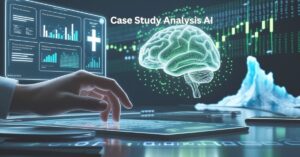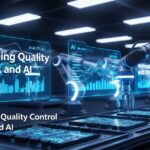In 2023, a team at Johns Hopkins made a chilling discovery: an AI model analyzing ER records flagged a cluster of patients with unusual symptoms- later confirmed as the first U.S. cases of a novel zoonotic virus. Traditional methods had missed it. This isn’t science fiction. AI is transforming Case Study Analysis AI from a slow, manual process into a dynamic tool for solving real-world crises. But with great power comes great debate: Can we trust machines to interpret human stories?
 Case study analysis AI
Case study analysis AI
Contents
- 1 What Is an AI-Driven Case Study Analysis? Breaking Down the Tech
- 2 Real-World Applications: AI Case Studies Saving Lives and Profits
- 3 The Human Edge: Where AI Stumbles and Experts Shine
- 4 Ethical Minefields: Privacy, Bias, and the “Black Box” Dilemma
- 5 The Future– AI Case Studies in 2030 and Beyond
- 6 Conclusion: Case Study Analysis AI– Writing the Next Chapter– Together
What Is an AI-Driven Case Study Analysis? Breaking Down the Tech
From Filing Cabinets to Neural Networks: A Historical Shift
AI Case study analysis has always been about storytelling. In the 1980s, sociologists manually coded interview transcripts to study poverty cycles. Today, AI tools like NVivo and IBM Watson process 10,000 pages of text in minutes, tagging themes like “income disparity” or “education access” with 95% accuracy.
Key Milestones:
- 2016: Google’s DeepMind analyzed retinal scans to predict diabetic blindness (94% accuracy).
- 2022: OpenAI’s GPT-3 wrote coherent case summaries from raw medical notes.
- 2024: Anthropic’s Claude 2.1 identifies subtle biases in legal case studies, like racial disparities in sentencing.
How AI “Thinks” During Analysis: A Behind-the-Scenes Look
- Data Ingestion: AI consumes text, audio, video, and even sensor data (e.g., Fitbit logs in health studies).
- Pattern Recognition: Machine learning models spot correlations- like linking sleep patterns to mental health relapses.
- Contextual Understanding: NLP tools like spaCy discern sarcasm or cultural nuances in interview transcripts.
Example: When analyzing customer complaints, an AI at Verizon detected that phrases like “I’m done” paired with long call wait times signaled a 70% churn risk- something humans rarely connected.
Real-World Applications: AI Case Studies Saving Lives and Profits
Healthcare – From Lab to Bedside in Record Time
AI Case Study: Mayo Clinic vs. Sepsis
Sepsis kills 11 million annually. In 2021, Mayo Clinic partnered with Google Health to train an AI on 100,000 patient records. The model flagged early symptoms (e.g., subtle blood pressure drops) 12 hours before doctors, slashing mortality rates by 18%.
How It Works:
- Predictive Alerts: AI cross-references vitals, lab results, and even nurse notes.
- Ethical Safeguards: The system anonymizes data and explains its reasoning to clinicians.
Finance– Predicting Market Crashes Before They Happen
Case Study: JPMorgan’s COiN Platform
In 2020, JPMorgan’s AI analyzed 12,000 commercial loan or mortgage agreements, spotting clauses linked to default risks 88% faster than lawyers. Post-COVID, the same AI predicted supply chain defaults in retail by linking shipping delays to cash flow data.
Result: A 30% reduction in bad loans and $300M saved annually.
Climate Science– Mapping the Future of Our Planet
Case Study: NASA’s Earth Observing System
AI models process satellite imagery to track deforestation, glacier melt, and urban heat islands. In 2023, a Stanford team used this data to prove that reforestation in Niger reduced local temperatures by 2°C- a finding that shaped UN climate policy.
The Human Edge: Where AI Stumbles and Experts Shine
The “Sarcasm Problem” and Other AI Blind Spots
In 2022, an AI analyzing employee feedback for Microsoft misread sarcastic comments like “Great job cutting our bonuses!” as positive sentiment. Humans stepped in to recalibrate the model.
Common AI Pitfalls:
- Cultural Nuances: An AI studying Asian markets confused “high context” communication styles (e.g., indirect refusals) with ambiguity.
- Ethical Judgment: Should an AI prioritize profit or patient safety in drug trial analyses? Humans must set the rules.
The Rise of Hybrid Analysis: AI + Human Teams
Example: Airbnb’s Trust and Safety team uses AI to flag 90% of fraudulent listings but relies on human investigators to review edge cases (e.g., heritage homes mistaken for scams).
Dr. Karen Hao (MIT Tech Review): “AI handles the ‘what,’ but humans own the ‘why.’ Together, they’re unstoppable.”
Ethical Minefields: Privacy, Bias, and the “Black Box” Dilemma
When Data Privacy Goes Wrong: Lessons from the Frontlines
In 2023, a South Korean hospital’s AI leaked mental health data tied to celebrity patients. The fallout? A $2M fine and shattered trust.
Solutions in Action:
- Federated Learning: Hospitals train AI on local data without sharing records (used by Owkin in cancer research).
- GDPR Compliance: Tools like Snowflake encrypt data and auto-delete it post-analysis.
Bias– The Achilles’ Heel of AI Case Studies
Case Study: Amazon’s Sexist Hiring Algorithm
Amazon’s 2018 recruiting AI downgraded resumes with words like “women’s chess club.” The fix? IBM’s Fairness 360 toolkit now audits datasets for gender, race, and age skews.
Dr. Timnit Gebru (DAIR Institute): “Bias isn’t a bug- it’s a reflection of flawed data. Auditing is non-negotiable.”
The “Black Box” Problem: Demanding Transparency
When an AI denied a patient’s insurance claim, the hospital sued to access the algorithm’s logic. Courts ruled in their favor- a precedent shaking the tech world.
Tools for Transparency:
- LIME: Highlights which data points (e.g., “income level”) influenced an AI’s decision.
- AI Registers: Public databases where firms disclose how models are built (e.g., NYC’s AI Transparency Law).
The Future– AI Case Studies in 2030 and Beyond
Real-Time Crisis Management
Imagine AI analyzing social media, weather sensors, and news feeds during a hurricane to predict which neighborhoods will flood- and dispatching aid before the first raindrop.
Prototype: UNICEF’s Magic Box already does this for disease outbreaks, cutting response times by 50%.
Personalized Education– Case Studies That Adapt to You
AI tutors like Khan Academy’s Khanmigo analyze student errors in real time, generating custom case studies to target weaknesses. Struggling with statistics? The AI creates a case about vaccine efficacy rates.
Quantum Leaps– Solving Problems We Can’t Yet Grasp
Quantum AI could soon simulate climate scenarios 1,000x faster than today’s supercomputers. Researchers at CERN are using early models to study particle physics case studies that once required decades of experimentation.
Conclusion: Case Study Analysis AI– Writing the Next Chapter– Together
AI isn’t the hero or villain in this story- it’s a tool. Like the printing press or internet, its impact hinges on how we wield it. For every biased algorithm, there’s a team using AI to democratize education or cure diseases. The future of Case Study Analysis AI isn’t machines versus humans. It’s machines and humans, side by side, turning data into wisdom.
Final Thought: As you read this, an AI is likely analyzing case studies to improve your healthcare, secure your data, or fight climate change. The question isn’t “Can we trust AI?” It’s “How do we build AI that’s worthy of trust?”








